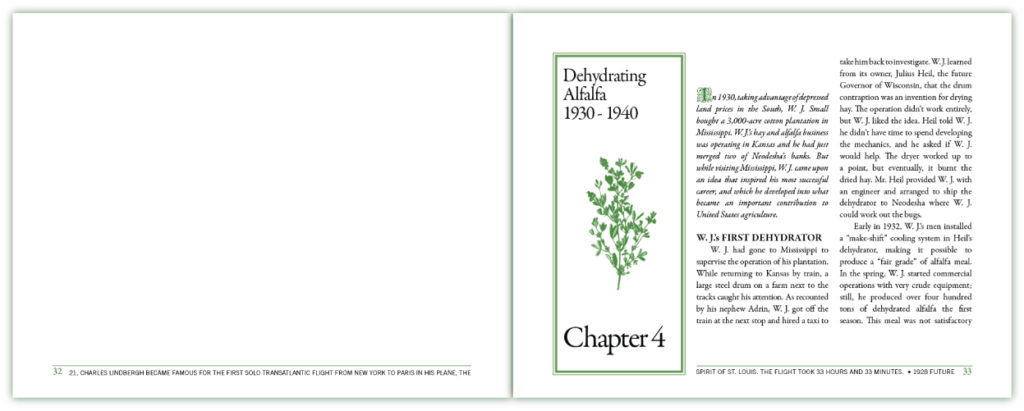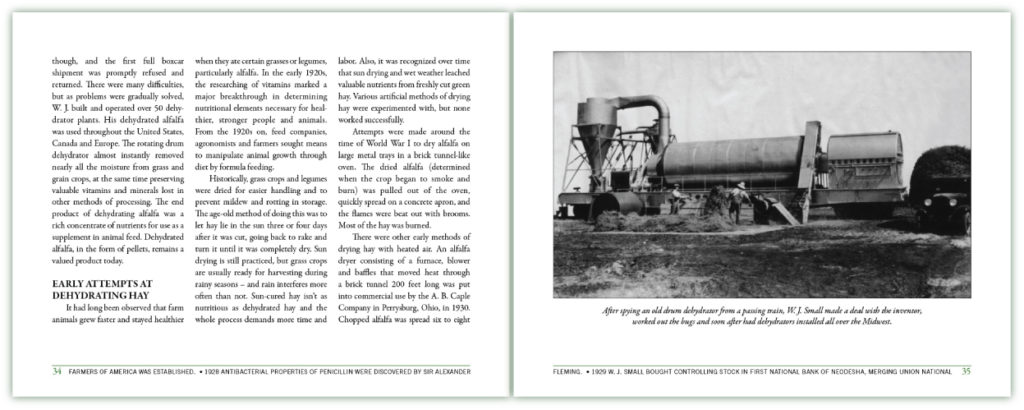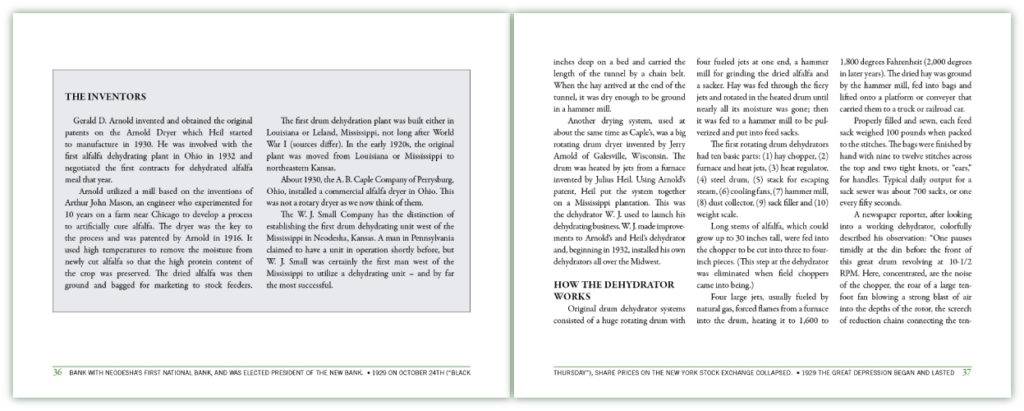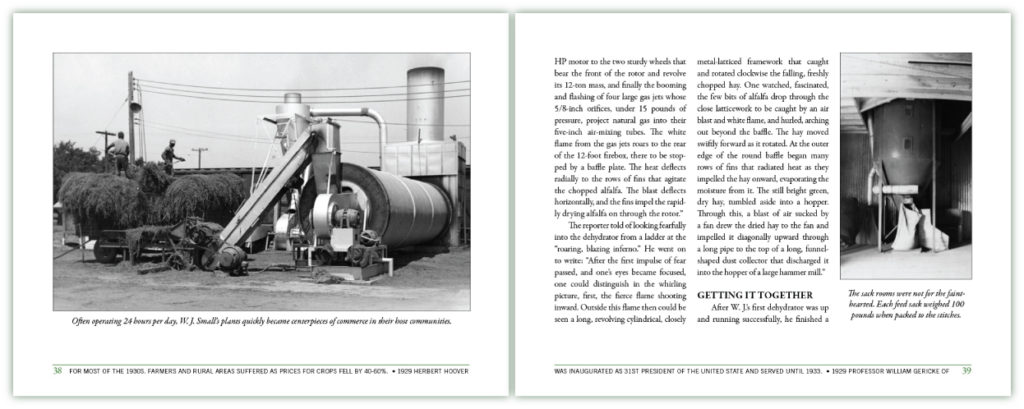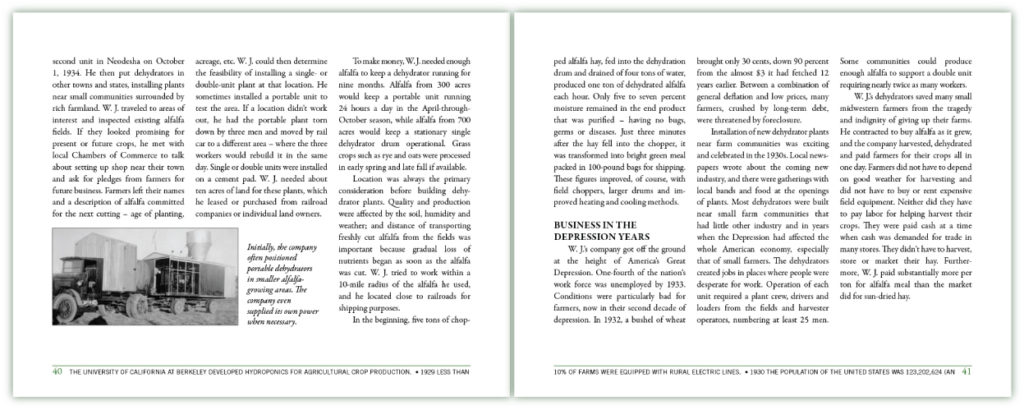Chapter 4. Dehydrating Alfalfa 1930 – 1940
In 1930, taking advantage of depressed land prices in the South, W. J. Small bought a 3,000-acre cotton plantation in Mississippi. W. J.’s hay and alfalfa business was operating in Kansas and he had just merged two of Neodesha’s banks. But while visiting Mississippi, W. J. came upon an idea that inspired his most successful career, and which he developed into what became an important contribution to United States agriculture.
W. J.’s FIRST DEHYDRATOR
W. J. had gone to Mississippi to supervise the operation of his plantation. While returning to Kansas by train, a large steel drum on a farm next to the tracks caught his attention. As recounted by his nephew Adrin, W. J. got off the train at the next stop and hired a taxi to take him back to investigate. W. J. learned from its owner, Julius Heil, the future Governor of Wisconsin, that the drum contraption was an invention for drying hay. The operation didn’t work entirely, but W. J. liked the idea. Heil told W. J. he didn’t have time to spend developing the mechanics, and he asked if W. J. would help. The dryer worked up to a point, but eventually, it burnt the dried hay. Mr. Heil provided W. J. with an engineer and arranged to ship the dehydrator to Neodesha where W. J. could work out the bugs.
Early in 1932, W. J.’s men installed a “make-shift” cooling system in Heil’s dehydrator, making it possible to produce a “fair grade” of alfalfa meal. In the spring, W. J. started commercial operations with very crude equipment; still, he produced over four hundred tons of dehydrated alfalfa the first season. This meal was not satisfactory though, and the first full boxcar shipment was promptly refused and returned. There were many difficulties, but as problems were gradually solved, W. J. built and operated over 50 dehydrator plants. His dehydrated alfalfa was used throughout the United States, Canada and Europe. The rotating drum dehydrator almost instantly removed nearly all the moisture from grass and grain crops, at the same time preserving valuable vitamins and minerals lost in other methods of processing. The end product of dehydrating alfalfa was a rich concentrate of nutrients for use as a supplement in animal feed. Dehydrated alfalfa, in the form of pellets, remains a valued product today.
EARLY ATTEMPTS AT DEHYDRATING HAY
It had long been observed that farm animals grew faster and stayed healthier when they ate certain grasses or legumes, particularly alfalfa. In the early 1920s, the researching of vitamins marked a major breakthrough in determining nutritional elements necessary for healthier, stronger people and animals. From the 1920s on, feed companies, agronomists and farmers sought means to manipulate animal growth through diet by formula feeding.
Historically, grass crops and legumes were dried for easier handling and to prevent mildew and rotting in storage. The age-old method of doing this was to let hay lie in the sun three or four days after it was cut, going back to rake and turn it until it was completely dry. Sun drying is still practiced, but grass crops are usually ready for harvesting during rainy seasons – and rain interferes more often than not. Sun-cured hay isn’t as nutritious as dehydrated hay and the whole process demands more time and labor. Also, it was recognized over time that sun drying and wet weather leached valuable nutrients from freshly cut green hay. Various artificial methods of drying hay were experimented with, but none worked successfully.
Attempts were made around the time of World War I to dry alfalfa on large metal trays in a brick tunnel-like oven. The dried alfalfa (determined when the crop began to smoke and burn) was pulled out of the oven, quickly spread on a concrete apron, and the flames were beat out with brooms. Most of the hay was burned.
There were other early methods of drying hay with heated air. An alfalfa dryer consisting of a furnace, blower and baffles that moved heat through a brick tunnel 200 feet long was put into commercial use by the A. B. Caple Company in Perrysburg, Ohio, in 1930. Chopped alfalfa was spread six to eight inches deep on a bed and carried the length of the tunnel by a chain belt. When the hay arrived at the end of the tunnel, it was dry enough to be ground in a hammer mill.
Another drying system, used at about the same time as Caple’s, was a big rotating drum dryer invented by Jerry Arnold of Galesville, Wisconsin. The drum was heated by jets from a furnace invented by Julius Heil. Using Arnold’s patent, Heil put the system together on a Mississippi plantation. This was the dehydrator W. J. used to launch his dehydrating business. W. J. made improvements to Arnold’s and Heil’s dehydrator and, beginning in 1932, installed his own dehydrators all over the Midwest.
HOW THE DEHYDRATOR WORKS
Original drum dehydrator systems consisted of a huge rotating drum with four fueled jets at one end, a hammer mill for grinding the dried alfalfa and a sacker. Hay was fed through the fiery jets and rotated in the heated drum until nearly all its moisture was gone; then it was fed to a hammer mill to be pulverized and put into feed sacks.
The first rotating drum dehydrators had ten basic parts: (1) hay chopper, (2) furnace and heat jets, (3) heat regulator, (4) steel drum, (5) stack for escaping steam, (6) cooling fans, (7) hammer mill, (8) dust collector, (9) sack filler and (10) weight scale.
Long stems of alfalfa, which could grow up to 30 inches tall, were fed into the chopper to be cut into three to four-inch pieces. (This step at the dehydrator was eliminated when field choppers came into being.) Four large jets, usually fueled by natural gas, forced flames from a furnace into the drum, heating it to 1,600 to 1,800 degrees Fahrenheit (2,000 degrees in later years). The dried hay was ground by the hammer mill, fed into bags and lifted onto a platform or conveyer that carried them to a truck or railroad car.
Properly filled and sewn, each feed sack weighed 100 pounds when packed to the stitches. The bags were finished by hand with nine to twelve stitches across the top and two tight knots, or “ears,” for handles. Typical daily output for a sack sewer was about 700 sacks, or one every fifty seconds.
A newspaper reporter, after looking into a working dehydrator, colorfully described his observation: “One pauses timidly at the din before the front of this great drum revolving at 10-1/2 RPM. Here, concentrated, are the noise of the chopper, the roar of a large ten-foot fan blowing a strong blast of air into the depths of the rotor, the screech of reduction chains connecting the ten-HP motor to the two sturdy wheels that bear the front of the rotor and revolve its 12-ton mass, and finally the booming and flashing of four large gas jets whose 5/8-inch orifices, under 15 pounds of pressure, project natural gas into their five-inch air-mixing tubes. The white flame from the gas jets roars to the rear of the 12-foot firebox, there to be stop-ped by a baffle plate. The heat deflects radially to the rows of fins that agitate the chopped alfalfa. The blast deflects horizontally, and the fins impel the rapid-ly drying alfalfa on through the rotor.”
The reporter told of looking fearfully into the dehydrator from a ladder at the “roaring, blazing inferno.” He went on to write: “After the first impulse of fear passed, and one’s eyes became focused, one could distinguish in the whirling picture, first, the fierce flame shooting inward. Outside this flame then could be seen a long, revolving cylindrical, closely metal-latticed framework that caught and rotated clockwise the falling, freshly chopped hay. One watched, fascinated, the few bits of alfalfa drop through the close latticework to be caught by an air blast and white flame, and hurled, arching out beyond the baffle. The hay moved swiftly forward as it rotated. At the outer edge of the round baffle began many rows of fins that radiated heat as they impelled the hay onward, evaporating the moisture from it. The still bright green, dry hay, tumbled aside into a hopper. Through this, a blast of air sucked by a fan drew the dried hay to the fan and impelled it diagonally upward through a long pipe to the top of a long, funnel-shaped dust collector that discharged it into the hopper of a large hammer mill.”
GETTING IT TOGETHER
After W. J.’s first dehydrator was up and running successfully, he finished a second unit in Neodesha on October 1, 1934. He then put dehydrators in other towns and states, installing plants near small communities surrounded by rich farmland. W. J. traveled to areas of interest and inspected existing alfalfa fields. If they looked promising for present or future crops, he met with local Chambers of Commerce to talk about setting up shop near their town and ask for pledges from farmers for future business. Farmers left their names and a description of alfalfa committed for the next cutting – age of planting, acreage, etc. W. J. could then determine the feasibility of installing a single- or double-unit plant at that location. He sometimes installed a portable unit to test the area. If a location didn’t work out, he had the portable plant torn down by three men and moved by rail car to a different area – where the three workers would rebuild it in the same day. Single or double units were installed on a cement pad. W. J. needed about ten acres of land for these plants, which he leased or purchased from railroad companies or individual land owners.
To make money, W. J. needed enough alfalfa to keep a dehydrator running for nine months. Alfalfa from 300 acres would keep a portable unit running 24 hours a day in the April-through-October season, while alfalfa from 700 acres would keep a stationary single dehydrator drum operational. Grass crops such as rye and oats were processed in early spring and late fall if available.
Location was always the primary consideration before building dehydrator plants. Quality and production were affected by the soil, humidity and weather; and distance of transporting freshly cut alfalfa from the fields was important because gradual loss of nutrients began as soon as the alfalfa was cut. W. J. tried to work within a 10-mile radius of the alfalfa he used, and he located close to railroads for shipping purposes.
In the beginning, five tons of chop-ped alfalfa hay, fed into the dehydration drum and drained of four tons of water, produced one ton of dehydrated alfalfa each hour. Only five to seven percent moisture remained in the end product that was purified – having no bugs, germs or diseases. Just three minutes after the hay fell into the chopper, it was transformed into bright green meal packed in 100-pound bags for shipping. These figures improved, of course, with field choppers, larger drums and im-proved heating and cooling methods.
BUSINESS IN THE DEPRESSION YEARS
W. J.’s company got off the ground at the height of America’s Great Depression. One-fourth of the nation’s work force was unemployed by 1933. Conditions were particularly bad for farmers, now in their second decade of depression. In 1932, a bushel of wheat brought only 30 cents, down 90 percent from the almost $3 it had fetched 12 years earlier. Between a combination of general deflation and low prices, many farmers, crushed by long-term debt, were threatened by foreclosure.
Installation of new dehydrator plants near farm communities was exciting and celebrated in the 1930s. Local news-papers wrote about the coming new industry, and there were gatherings with local bands and food at the openings of plants. Most dehydrators were built near small farm communities that had little other industry and in years when the Depression had affected the whole American economy, especially that of small farmers. The dehydrators created jobs in places where people were desperate for work. Operation of each unit required a plant crew, drivers and loaders from the fields and harvester operators, numbering at least 25 men. Some communities could produce enough alfalfa to support a double unit requiring nearly twice as many workers.
W. J.’s dehydrators saved many small midwestern farmers from the tragedy and indignity of giving up their farms. He contracted to buy alfalfa as it grew, and the company harvested, dehydrated and paid farmers for their crops all in one day. Farmers did not have to depend on good weather for harvesting and did not have to buy or rent expensive field equipment. Neither did they have to pay labor for helping harvest their crops. They were paid cash at a time when cash was demanded for trade in many stores. They didn’t have to harvest, store or market their hay. Furthermore, W. J. paid substantially more per ton for alfalfa meal than the market did for sun-dried hay.

